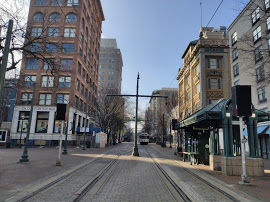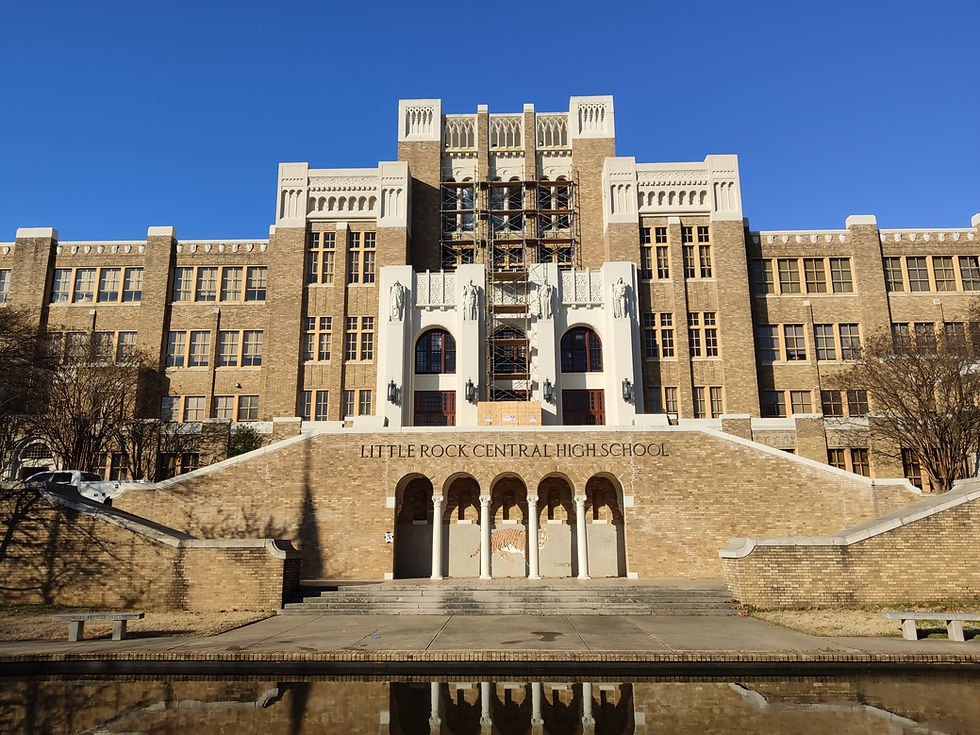Arkansas: The "Mid-South"
- Aaron Schorr

- Jan 18, 2021
- 8 min read
Arkansas doesn’t really belong in the Deep South and I wanted to give Texas its own entry, so Arkansas got one, too, despite us spending less than two days in it. This is only fitting, since Arkansas defines itself as the "mid-south", which as far as I'm concerned is not a coherent geographic unit.

We woke up determined to leave nightmarish lodgings as quickly as we could, only to discover the car was had received a fine coating of ice overnight. The receptionist gave us a tiny ice scraper the size and shape of a lice comb, and I thought I would be the first person in modern Tennessee history to get frostbite in a city scraping it off. Downtown Memphis was actually much more attractive in the daytime than I had imagined it. There were the usual big brick buildings we had seen in every medium-sized city to the east, but the cobblestoned main drag was shared between pedestrians and actual trollies, which the rest of the group had already taken to calling “white people buses” - an achievement of which I was very proud (Disclaimer: while the trollies in Memphis were admittedly built as a means of transportation and not as a tourist attraction, the fact that only one line remains in the touristy downtown says all you need to know about it).

After a hearty breakfast in another very Black restaurant that had pictures of the founder marching with Martin Luther King hanging from the walls, we set off across the mighty, muddy Mississippi and crossed into Arkansas. The transition into flyover country was instant, the rolling hills replaced by occasionally wooded plains stretching as far as the horizon and the highway completely filled with trucks making their way across the country and keeping us below the almost European speed limit of 75 mph.
Slow Travel in Forrest City
We pulled off the highway to charge in a Walmart parking lot in the town of Forrest City, 60 miles west of the Mississippi. To our dismay, the charging station only had plugs that were incompatible with the Tesla charging receptacle, and a Google search revealed that we were out of luck without a highly specific adapter. We didn’t have enough charge to make it to the supercharger in Little Rock, but the car predicted we would have 4% remaining if we chose to return to Memphis and charge there. This sounded both risky and hugely inconvenient, so we chose instead to look for an apparently compatible charger in the town of Wynne, 15 miles to the north. We went into maximum battery-saving mode, killing the air conditioning and the music, avoiding the cruise control and keeping the speed below 50 mph. Without ventilation, the windshield and windows were fogging up so quickly that Jake had to run a t-shirt over them every few minutes so I could see where I was going. We arrived in Wynne and found the communitly learning center where the charger was apparently located. I parked outside and headed inside to ask if we could use their charger, but the woman at the front desk said they didn’t have one. I headed around back to check and found one, but the receptionist, now joined by another woman, said she would have to check with her “main office” to see if we could use it, despite us offering to pay for the electricity. I felt like I was back in the army waiting for the mindless bureaucracy to get its act together. We waited outside for several painstakingly long minutes until the women returned and said we could use the charger. I practically threw my driver’s license at them so they could write down my information as I moved the car around back. Richard hopped out and connected the charger in record time and I waited for the words “ready to charge” to change to “starting to charge”. Alas, no such luck. We tried several times but the charger simply wouldn’t power the car. We thanked the women (for nothing) and tried a nearby Chevrolet dealership which allegedly had a charger. They didn’t have one, but they were much more helpful and tried finding us a dealership in the area which did, more like the small-town spirit I had expected. There was apparently a town 60 miles to the west with a charger; the car said we had a projected range of 62 miles, which I expected to be able to extend to around 70 by keeping our speed and energy consumption to a bare minimum.

Jake found a hotel that had a Tesla charger back near the interstate, so we crept the 15 miles back to Forrest City even slower than the way there. We got to the hotel and our hearts sank as we saw that the charger was being used by another Tesla, even if that at least meant that the charger worked. In an incredible stroke of luck, the owners of the vehicle immediately materialized and drove off, freeing up the charger for our use. This was a so-called Level 1 charger, providing us with a steady current of 6 kilowatts. For comparison, most Tesla superchargers provide up to 150 kW, with some going as high as 250. At this charging speed, it would take us 3 hours to reach a charge with which I would be comfortable setting off to Little Rock, 100 miles away. With 3 hours to burn, we had a consolation ice cream and returned to the main source of entertainment in town, which was none other that our mortal enemy Walmart.
We browsed every aisle and set up an impromptu fitness circuit in the weights aisle, until that drew too many curious glances from employees. I learned that I could have bought a number of guns with nothing more than my driver’s license, which I had genuinely thought was a myth. Printing photos of Shervin turned out to be another good way to burn time, as the man operating the printer seemed to have no idea how to do so. We couldn’t even use the bathroom, which was plastered with explosive diarrhea.


When even Walmart couldn’t alleviate our boredom, we found a gazebo behind a neighboring hotel and waited for the car to reach the coveted 62% charge. The one upside was that it was sunny for the first time in days and the temperature was in the 50s, which felt downright balmy after a week of temparatures near or below freezing since entering Virginia for the first time.
Little Rock: Western Sprawl and Southern History
We finally set off towards Little Rock, tracking massive bird formations migrating west as we did so. This section of I-40 also seemed to attract massive formations of trucks heading west, turning the two-lane highway into a giant game of tetris. We crossed the Arkansas River at sunset and reached the supercharger with charge to spare, with high fives all around. Dinner was downright festive at a nice Italian restarant downtown, thrilled that we weren’t spending the night in Forrest City, Arkansas.
Little Rock was the first city we visited west of the Mississippi and our first taste of true sprawl, the defining feature of cities in the western U.S. Admittedly, some Southern cities we had visited were sprawling as well (Knoxville and Fayetteville come to mind), not to mention greater Miami, but things were stepping up several notches in Little Rock. Apart from the Arkansas River, there are no defining features to the city, which is a vast radial mass of suburbs surrounding a compact downtown plopped down in the middle of the Arkansas plains. After driving for miles on the interstate disecting the city, I was genuinely astonished to discover the entire population of Little Rock was a meager 200,000.

After a good night’s sleep to recover from the previous day’s misfortunes, we headed back downtown to visit Little Rock Central High School, another civil rights landmark. After the Supreme Court ruled that segregation in schools was unconstitutional in 1954, nine Black students enrolled at the school in 1957. Their enrollment triggered a crisis in the state government and widespread protests in the school, and the governor of Arkansas mobilized the state’s National Guard to prevent the students from entering the school by force. In response, President Eisenhower sent in troops from the 101st Airborne Division to ensure the students’ entry to the school, drawing national and worldwide attention to the issue of segregation. I felt disheartened that people could care so much about excluding Black students from their schools that two separate military units had to be called in only 64 years ago, but at the same time the courage of these students in the face of violent racism was awe-inspiring. In the current political landscape in the United States and following the events of the summer of 2020, where at least in my mind certain debates (especially regarding race relations) have the very obvious split into right and wrong, I feel that there is a lesson to be learned from the Little Rock Nine and I am happy that the school is still in use today.

We had breakfast at a hip café downtown and departed the city. This turned out to be more easily said than done, as the first 30 miles of the drive on I-30 were a dystopian mass of strip malls blending into one another. We left the interstate and started regaining some topography, climbing into green forested hills. A large sign proclaimed that we had arrived in Hot Springs, childhood home of Bill Clinton.
Hot Springs is a window into a bygone era of America, before cheap air travel allowed Americans to travel to Mexico, Hawaii, and the Caribbean en masse. Back when driving was the only realistic way to go on vacation, Hot Springs was the destination of choice for many, with notable faces such as Joe DiMaggio and Al Capone making regular appearances. The city is divided into two by the pincers of Hot Springs National Park, with historic Bathhouse Row serving as a bridge between the two halves. The Row, unsurprisingly, is home to a string of historic bathhouses feeding off the city’s namesake, and has undoubtedly seen better days. Only two of the bathhouses are still in operation, and only one of those has operated continuously since the town’s heyday. The buildings are still grand and evoke images of the Gilden Age, even if some of them are somewhat worse for wear.
It was impossible to visit the only open bathhouse without a reservation, so we strolled around the springs behind Bathhouse Row. The water comes out at nearly 150˚F, too hot to touch for more than an instant, but it’s still pretty. We hiked up the mountain behind the Row and got a good, if somewhat hazy, view of the surrounding mountains. It was 63˚ and sunny, allowing us to wear nothing more than t-shirts for the first time since leaving Savannah, GA. Being outside in the warm sun was absolutely glorious, and we hoped this weather was here to stay.


We split up heading down the mountain, had a look at the semi-famous Arlington Hotel where celebrities would stay, and departed Hot Springs on a state route that felt like it belonged in more dramatic mountain scenery. The initial plan had been to continue west through the Queen Wilhelmina Forest and spend a night in Broken Bow, a Choctaw casino town in the southeastern corner of Oklahoma, but the route was iffy in terms of charging opportunities and the scenery wasn’t anywhere near its prime in January, so we continued on I-30 towards Dallas.

As we rejoined the interstate heading southwest, the green hills became flatter and more brown, until the arrival of flat prairie signalled we were rapidly approaching Texas. Our plan had been to spend the night in Texarkana, the creatively-named city straddling the Arkansas-Texas state line. We arrived in the early afternoon and there was nothing to do in town, so we decided to continue onwards.











Comments